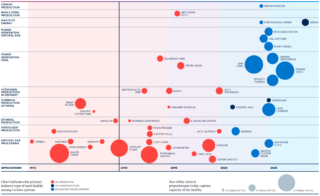-
Global CCS Institute publishes 2020 ‘global status of CCS’ report with a new way of categorising and counting facilities
Date posted:
-
-
-
Post Author
Philip SharmanIFRF Director
-
-
![]()
Last week, the Australian-headquartered Global CCS Institute published its ‘Global Status of CCS 2020’ report with the strapline ‘CCS – vital to achieve net-zero’.
“The road ahead is challenging,” says the Institute’s CEO, Brad Page, “but CCS is increasingly well-placed to make its significant and necessary contribution to achieving net-zero emissions around mid-century.”
The report – the latest edition of these annual status reports – identifies four main ways that investment in CCS can help in reaching net-zero emissions:
- achieving deep decarbonisation in ‘hard-to-abate’ industries such as cement, iron & steel and chemicals
- enabling the production of low-carbon hydrogen at scale (i.e. ‘blue hydrogen’ – hydrogen produced from fossil fuel sources but with CCS used to capture associated CO2 emissions)
- providing low-carbon ‘dispatchable’ power
- delivering ‘negative emissions’ (i.e. via bioenergy with CCS – BECCS – or direct air capture with carbon storage – DACCS).
Probably the part of the report of most interest to IFRF members is the ‘chapter’ on global CCS facilities and trends.
In a significant departure from its previous practice of categorising CCS facilities as either ‘large-scale’ or ‘pilot and demonstration’ facilities, the Global CCS Institute has adopted a new system of categorisation – into either ‘commercial CCS facilities’ or ‘pilot and demonstration-scale CCS facilities’… Why? Well, whereas its raison d’être has, until now, been to encourage the development of CCS facilities large enough to demonstrate CCS at a commercially-relevant scale, the Institute now sees its focus as encouraging the deployment of commercially-available, mature CCS technologies, which may be smaller but still viable (e.g. in the context of an industrial CCS ‘cluster’). Behind this subtle (and sensible) re-categorisation is the recognition that one of the big factors driving CCS growth is that, in order to achieve net-zero greenhouse gas emissions, CCS deployment is increasingly urgent.
Under the Global CCS Institute’s new system of categorising and counting CCS facilities, there are currently 65 ‘commercial CCS facilities’ – 26 operating, two having suspended operations (one for economic reasons, one due to a fire), three under construction, 13 in an advanced stage of development (i.e. reaching the front-end engineering and design – FEED – study stage) and 21 in an early stage of development. In addition, 34 ‘pilot and demonstration-scale CCS facilities’ are currently in operation or development, with a further eight CCS test centres around the world.
![]() The portfolio of commercial CCS facilities in various power and industrial applications (including those in operation, under construction and in advanced development) – a diagram from the report
The portfolio of commercial CCS facilities in various power and industrial applications (including those in operation, under construction and in advanced development) – a diagram from the report
The CO2 capture capacity of all of the plants that are operational in 2020 is around 40 million tonnes per annum. The primary challenge ahead is to see this increase to 5,635Mtpa by 2050 (including 369Mtpa of CO2 captured for use and storage) – the capacity that the International Energy Agency (IEA) see as necessary under its ‘Sustainable Development Scenario’.
The Global CCS Institute highlights three aspects of the recent growth in the commercial CCS pipeline as particularly noteworthy:
- Enhanced tax credits in the USA: US involvement in 12 of the 17 new facilities in 2020 is largely due to the enhanced ‘45Q’ tax credit signed into law in 2018, with the Internal Revenue Service (IRS) issuing more detailed guidance in 2020 (see also IFRF Combustion Industry News blogpost from March). Some US facilities will also benefit from the California low-carbon fuel standard (LCFS) – credits under this scheme were trading at up to US $212/tCO2 during 2020.
- Hubs and clusters: These significantly reduce the unit cost of CO2 storage through ‘economies of scale’ and offer commercial synergies that reduce investment risk. Most new US commercial facilities have the opportunity to access CarbonSAFE CO2 storage hubs which are under development and supported by the US Department of Energy (US DOE). Furthermore, the two new commercial facilities under development in the UK are both associated with Zero Carbon Humber, which aims to be the UK’s first net-zero industrial cluster.
- Hydrogen – a fuel of the future: Coal gasification or natural gas reforming with CCS, are currently the lowest cost options for producing commercial quantities of clean hydrogen. Jockeying for a chance to win market share in clean hydrogen supply is a significant factor in the growth of early-stage CCS project studies. Examples include Project Pouakai Hydrogen Production in New Zealand, the Hydrogen Energy Supply Chain project in Australia (pilot plant currently under construction) and the Hydrogen-to-Humber Saltend project – one of many large-scale hydrogen projects in development in the UK.
The report also gives an update on the development of policies and regulations by regions of the world, and an overview of the global CO2 storage capacity in oil & gas fields and saline formations (noting that “storage capacity is not a constraint” to CCS), before going on to examine CCS activity around the world on a region-by-region basis.
So, does the ‘Global Status of CCS 2020’ report provide evidence that justifies its strapline ‘CCS – vital to achieve net-zero’? Personally, I believe that the current status of CCS is more positive now than it has been in the last 3-5 years, largely due to the shift in focus from decarbonising power generation via CCS to using CCS, to helping to decarbonise hard-to-abate CO2 emissions from industrial processes via hubs and clusters, and as an ‘enabler’ for low-cost hydrogen production at scale. So yes, I for one think it does… and I’m not alone in this view, with Dr Fatih Birol, Executive Director of the IEA, (and who I rate highly) stating publicly that “… the IEA has identified that reaching net-zero emissions will be virtually impossible without CCUS.”
Well worth a peruse!


